Before you Begin
This 30-minute tutorial shows you how to add an indirect project and define assumptions for standard rates and work time. The sections build on each other and should be completed sequentially.
Background
With Projects, you can bridge the gap between project planning systems and the financial planning process. You can assess the impact organizational projects and initiatives have on overall corporate resources and ensure they align with short and long term financial targets.
You can enable and plan for Contract, Capital, and Indirect project types.
In this tutorial, you add an indirect project and define assumptions for standard rates and work time.
Indirect projects, also called internal projects, have a cost impact but don’t generate revenue.
For example, an IT project that creates a portal for the Human Resources team to track personal details of employees is an Indirect project.
If a project is classified as Indirect, you can do only expense budgeting for the project. You can, however, plan financial and non-financial benefits of the project.
What Do You Need?
An EPM Cloud Service instance allows you to deploy and use one of the supported business processes. To deploy another business process, you must request another EPM Enterprise Cloud Service instance or remove the current business process.
- Have Service Administrator access to an EPM Enterprise Cloud Service instance. The instance should not have a business process created.
- Upload and import this snapshot into your instance.
Note:
If you run into migration errors importing the snapshot, re-run the migration excluding the HSS-Shared Services component, as well as the Security and User Preferences artifacts in the Core component. For more information on uploading and importing snapshots, refer to the Administering Migration for Oracle Enterprise Performance Management Cloud documentation.Reviewing User Variables
User Variables were added when the business process was created. User variables act as filters in forms, enabling planners to focus only on certain members. In this section, you review the values set for user variables.
- Click
 (Navigator), then under Tools, click User Preferences.
(Navigator), then under Tools, click User Preferences.
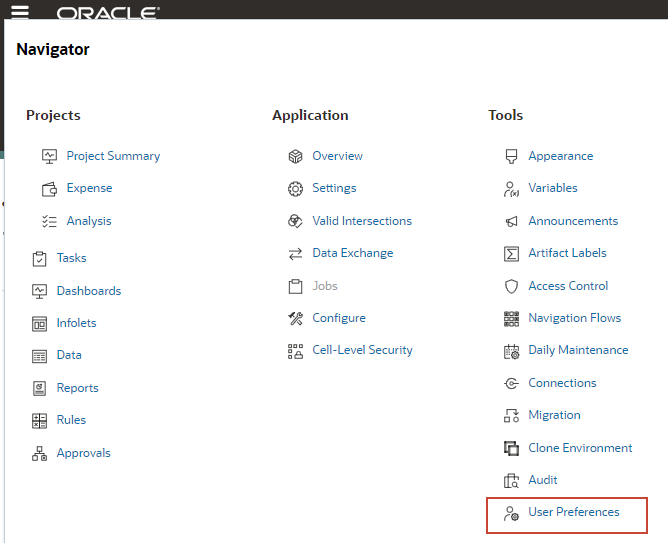
- On the left, click User Variables.
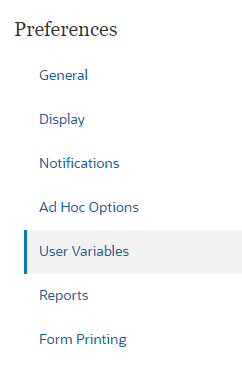
- Review the selected members for each dimension:
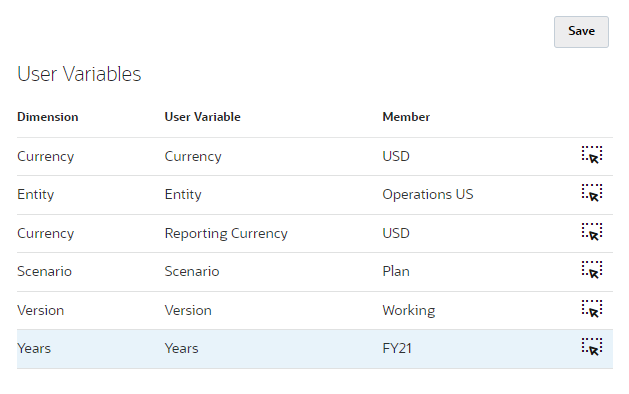
- Return to the home page. On the upper right, click
 (Home).
(Home).
Navigating the Indirect Project Tabs
In this section, you navigate to Projects and view the dashboards and forms associated with Indirect Projects.
- On the home page, click Projects, and then Project Summary.

Project Summary is opened with the Indirect vertical tab displayed. There is no data displayed on the Overview dashboard because there are no projects in this application.
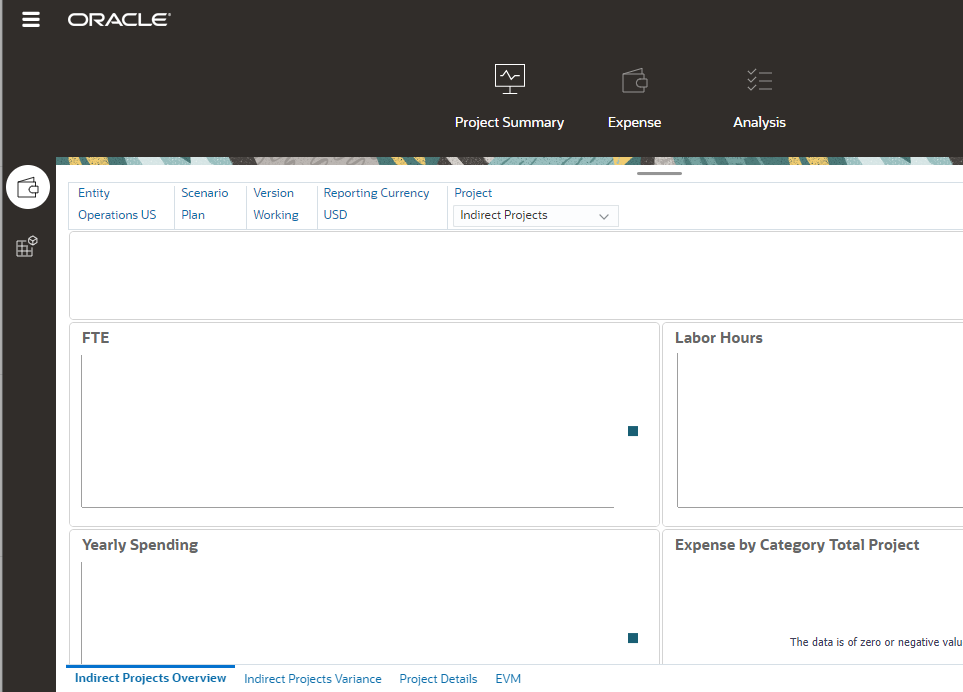
- Review the data point-of-view (POV) and click the Project dropdown list to display its options.

The POV members are taken from user variable values. The Project dropdown lists only Indirect Projects since only this type of project is enabled in the application.
- Click and review the following horizontal tabs:

- Indirect Projects Overview—displays a high-level dashboard-type overview of indirect projects.
- Indirect Projects Variance—enables you to perform variance analysis comparing budget and actuals for project plans.
- Project Details—enables you to manage and review projects and project details.
- EVM (Earned Value Management)—displays project schedule variances.
Adding an Indirect Project
- Click the Project Details horizontal tab.
- In the grid's whitespace, right-click and select Add Project.
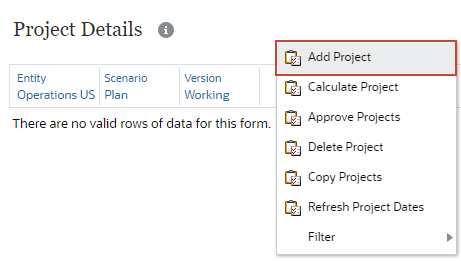
- In Add Project, enter or select the following:
Property Value Enter Project Name Digital Mobile Web Enter Project Start Date 4/1/22 Enter Project End Date 11/30/25 - Verify your entries and click Launch.
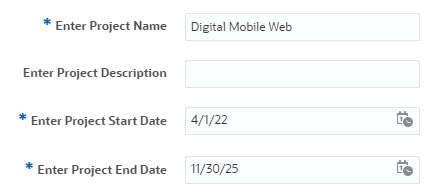
- At the information message, click OK.
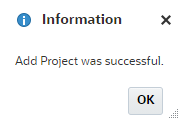
The project was added and displays on the form.

- For Digital Mobile Web, set the Project Priority to High.
- For Project Category, select Digital Transformation.
- Review your selections and click Save.
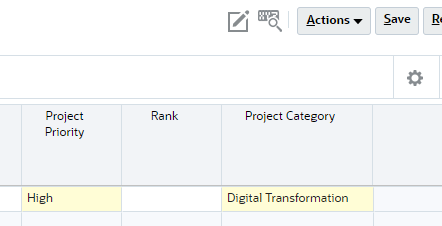
- At the information message, click OK.
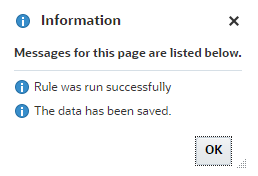
The background color of "dirty" (yellow) cells change to white when new or updated data is saved to Planning.

Tip:
You can set Override Standard Labor Rates and Override Equipment Rates to Yes if you want to explicitly define rates for the project instead of using assumptions.
Defining Assumptions
In this section, you set up assumptions that drive calculations for project-related expenses.
Navigating to the Assumptions Tab
- From the vertical tabs on the left, click
 (Assumptions).
(Assumptions).
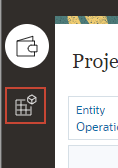
Assumptions opens with the Standard Rates horizontal tab displayed.
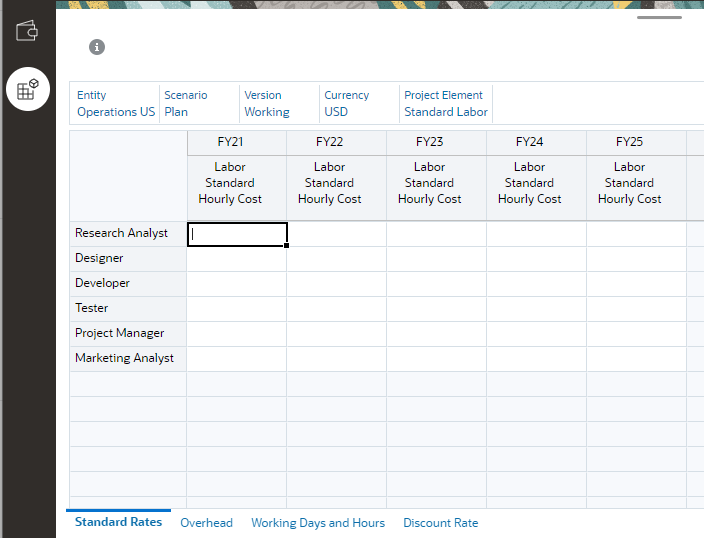
- Click and review the following horizontal tabs:
- Standard Rates—set standard rates for enabled expenses, such as labor, equipment, and materials.
In this tutorial, the application is enabled for labor and equipment driver-based expenses.
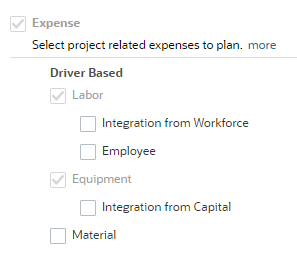
- Overhead—specify overhead for different accounts. For example, you can plan the overhead rate for Engineering or Manufacturing, or allocate a Facilities overhead.
- Working Days and Hours—specify the working days and hours in a month; it can vary by entity. For example, you can set different working days and hours for different regions or for different departments.
- Discount Rate—Specify the discount rate per year; used in net present value (NPV) calculations.
- Standard Rates—set standard rates for enabled expenses, such as labor, equipment, and materials.
Setting Standard Rates
- In Standard Rates, verify that the Project Element in the POV is set to Standard Labor.

- In the grid, enter the following values:
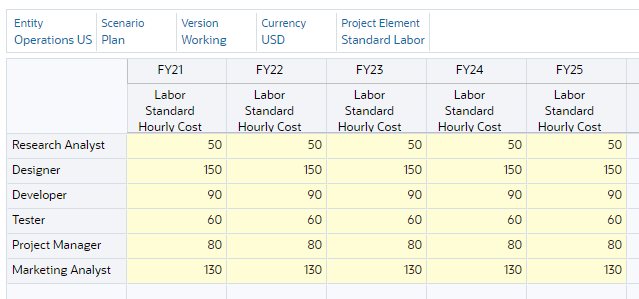
- Verify your entries and click Save.
When the background color of the "dirty" (yellow) cells turn to white, data is saved to Planning.
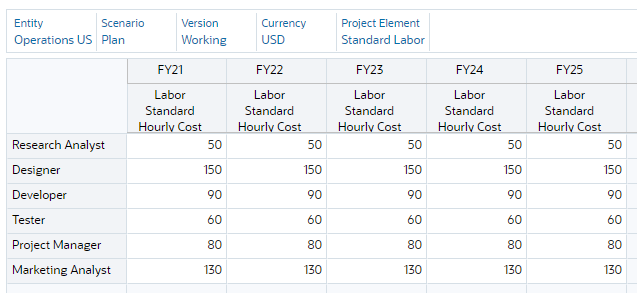
Setting Work Days and Hours
- From the horizontal tabs, click Working Days and Hours.
- In the grid, enter the following values:

- Verify your entries and click Save.
Data is saved to Planning.

Learn More
Adding Indirect Projects
F46353-02
April 2022
Copyright © 2022, Oracle and/or its affiliates.
This 30-minute tutorial shows you how to add an indirect project and define assumptions for standard rates and work time.
This software and related documentation are provided under a license agreement containing restrictions on use and disclosure and are protected by intellectual property laws. Except as expressly permitted in your license agreement or allowed by law, you may not use, copy, reproduce, translate, broadcast, modify, license, transmit, distribute, exhibit, perform, publish, or display any part, in any form, or by any means. Reverse engineering, disassembly, or decompilation of this software, unless required by law for interoperability, is prohibited.
If this is software or related documentation that is delivered to the U.S. Government or anyone licensing it on behalf of the U.S. Government, then the following notice is applicable:
U.S. GOVERNMENT END USERS: Oracle programs (including any operating system, integrated software, any programs embedded, installed or activated on delivered hardware, and modifications of such programs) and Oracle computer documentation or other Oracle data delivered to or accessed by U.S. Government end users are "commercial computer software" or "commercial computer software documentation" pursuant to the applicable Federal Acquisition Regulation and agency-specific supplemental regulations. As such, the use, reproduction, duplication, release, display, disclosure, modification, preparation of derivative works, and/or adaptation of i) Oracle programs (including any operating system, integrated software, any programs embedded, installed or activated on delivered hardware, and modifications of such programs), ii) Oracle computer documentation and/or iii) other Oracle data, is subject to the rights and limitations specified in the license contained in the applicable contract. The terms governing the U.S. Government's use of Oracle cloud services are defined by the applicable contract for such services. No other rights are granted to the U.S. Government.
This software or hardware is developed for general use in a variety of information management applications. It is not developed or intended for use in any inherently dangerous applications, including applications that may create a risk of personal injury. If you use this software or hardware in dangerous applications, then you shall be responsible to take all appropriate fail-safe, backup, redundancy, and other measures to ensure its safe use. Oracle Corporation and its affiliates disclaim any liability for any damages caused by use of this software or hardware in dangerous applications.
Oracle and Java are registered trademarks of Oracle and/or its affiliates. Other names may be trademarks of their respective owners.
Intel and Intel Inside are trademarks or registered trademarks of Intel Corporation. All SPARC trademarks are used under license and are trademarks or registered trademarks of SPARC International, Inc. AMD, Epyc, and the AMD logo are trademarks or registered trademarks of Advanced Micro Devices. UNIX is a registered trademark of The Open Group.
This software or hardware and documentation may provide access to or information about content, products, and services from third parties. Oracle Corporation and its affiliates are not responsible for and expressly disclaim all warranties of any kind with respect to third-party content, products, and services unless otherwise set forth in an applicable agreement between you and Oracle. Oracle Corporation and its affiliates will not be responsible for any loss, costs, or damages incurred due to your access to or use of third-party content, products, or services, except as set forth in an applicable agreement between you and Oracle.